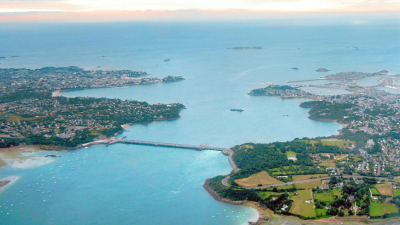The La Rance tidal power station in Brittany, France is the world’s first tidal power station. Inaugurated on November 26, 1996 and still operational, it is, naturally, the world’s oldest tidal power station as well. A.S Ganesh takes a look at tidal energy and the La Rance power station…
Our energy needs have constantly been on the rise throughout our existence with a burgeoning worldwide population and increased per capita energy consumption, the amount of energy that we need has been skyrocketing. Climate change and global warning in the midst of all this has pushed the conversation towards finding better alternatives than fossil fuels in items of energy sources.
A renewable source
Tidal energy is a renewable source of energy that is produced by the surge of ocean waters during the ebb and flow of tides. The production of tidal energy, however, is still in its infancy with only a small amount of power produced by it overall so far. This does not mean that the necessary technology isn’t available with us. Far from it. The ways to use tidal movement to produce electricity was developed by our scientists and engineers in the 20th Century.
Tidal range
Tidal energy is harnessed in area between low tide and high tide – the tidal range – is significant. One such area is on the Rance estuary at Ille-et-Vilaine in Brittancy, France. This area houses the La Rance tidal power station, the world’s first and oldest tidal power station. Tidal plants use a barrage or enclosure-type installation in order to build an artificial reservoir as they rely on the changing heads of water that tides bring to device the turbines that produce the electricity. The Rance river estuary is suited for this purpose owing to its large tidal range, with an average of 8m between low and high tides – a figure that can jump up to 13.5m in the spring and neap range.
Not easy to construct
While plans to build the La Rance began as early as 1943. it was nearly another quarter of a century before the completed structure was ready to use. Construction was no easy task as dams were raised to block the Rance river, so that the estuary was completely drained out and the reservoir’s establishment across the site could be facilitated.
On November 26, 1966, the La Rance tidal power plant was officially inaugurated by French President Charles de Gaulle. With a 330 m-long dam enclosing a 22 km2 area basin, the plant has a large reservoir of 184 million cubic meters. As bulb turbines allow for power generation both in the ebb and flood cycles of the tide, this plant houses 24 bulb turbines, each of which weights 470 tonnes with a 5.4 m diameter and a eating of 10 MW.
Low maintenance
Operated by Electricite de France (EDF). the plant has produced over 27,000 GWh of electricity in its over five decades of operation Maintenance requirements have been minimal as cathodic protection is employed for all the turbines, the gates and the metallic parts of the lock. This, despite the fact that each of the 24 bulb turbines have run for over 2,00,000 hours on average.
According to the details provided by EdF, ebb generation accounts for 60% of the total energy produced, free flow through the turbine orifices corresponds to 20%, pumping for 15-20% while flood generation is responsible only foe 2-6% of the energy generated.
Even though the La Rance power plant was built at a prohibitive initial cost of $ 100 million, the long-term rewards are there to see. In addition to paying for itself in its first 20 years, it has by now recovered all of its costs through the savings created by energy production.
Predictable, perpetual
Tidal energy can be a viable option in the search for replacements for fossil fuels. Not only does producing tidal energy cost less than nuclear or solar power, but it also has the advantage of being predictable and perpetual. Engineers have access to the cycles predicting the movement of tides from a daily basis to even an annual basis, allowing for little interruption in the energy generation. It is also not much influenced by weather, meaning it can keep generating electricity day and night foe as long as the plant is operational.
Despite the advantages of tidal energy, there are very few commercial –sized tidal power plants operational in the world at the moment. One of the major concerns or drawbacks that this form of energy generation has is its environmental impact.
Negative impact
Tidal power negatively impacts marine life by altering sedimentation patterns. The barrage causes progressive silting in the surrounding ecosystem, thereby affecting the native aquatic plants, fish and other organisms.
While La Rance continues to operate and produces energy that is equivalent to that consumed by city the size of Rennes, France, a lot more needs to be done if tidal energy is to become an alternative to conventional energy sources. Engineers and scientists worldwide are not only working to improve the technologies and costs involved, but are also looking at how best to minimize the impact on the environment.
Picture Credit : Google

